 Florida contributed more than 15,000 troops to the Confederate war effort. While this was a small number when compared with other southern states,
Florida contributed more than 15,000 troops to the Confederate war effort. While this was a small number when compared with other southern states,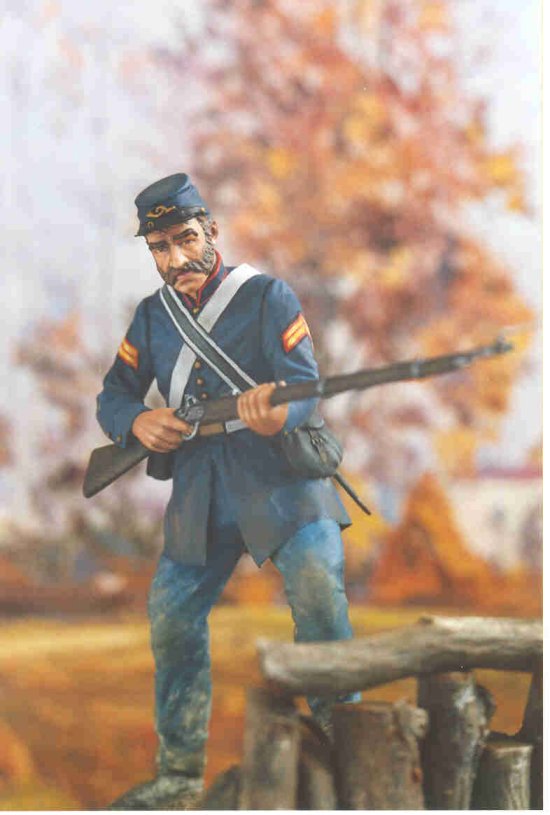 Florida troops were organized into eleven regiments of infantry; two regiments of cavalry; and numerous smaller units, including artillery, home-guard, and militia.
Florida troops were organized into eleven regiments of infantry; two regiments of cavalry; and numerous smaller units, including artillery, home-guard, and militia.  Corporal Seaborn Tiller of the 6th Florida Infantry Regiment (Museum of Florida History)
Corporal Seaborn Tiller of the 6th Florida Infantry Regiment (Museum of Florida History)  A photograph of southern troops in camp near Pensacola in 1861. (Florida State Archives)
A photograph of southern troops in camp near Pensacola in 1861. (Florida State Archives) 
Secession banner Even before Florida left the Union in January 1861, unofficial secession flags were flying in many parts of the state. A group from Duval County called "the Ladies of Broward's Neck" presented this flag to Governor Madison Starke Perry. The flag bore the motto "The Rights of the South at All Hazards!" and was displayed at the Florida capitol when the Ordinance of Secession was signed on January 11, 1861.(Collections of the Museum of Florida History) |

Colonel Chase's lone-star flag
In mid-January 1861, Colonel William H. Chase, the commander of Florida troops in Pensacola who were loyal to the South, raised this lone star emblem as the state's provisional military flag. Colonel Chase's soldiers had seized the federal navy yard in Pensacola during the crisis preceding the outbreak of the Civil War. The flag bears the same
provisional military flag. Colonel Chase's soldiers had seized the federal navy yard in Pensacola during the crisis preceding the outbreak of the Civil War. The flag bears the same design as that used by the navy of the Republic of Texas from 1836 to 1845.
design as that used by the navy of the Republic of Texas from 1836 to 1845. 
In mid-January 1861, Colonel William H. Chase, the commander of Florida troops in Pensacola who were loyal to the South, raised this lone star emblem as the state's
 provisional military flag. Colonel Chase's soldiers had seized the federal navy yard in Pensacola during the crisis preceding the outbreak of the Civil War. The flag bears the same
provisional military flag. Colonel Chase's soldiers had seized the federal navy yard in Pensacola during the crisis preceding the outbreak of the Civil War. The flag bears the same design as that used by the navy of the Republic of Texas from 1836 to 1845.
design as that used by the navy of the Republic of Texas from 1836 to 1845. 
In January 1861, as Florida seceded from the Union, U.S. Army officers stationed at Pensacola and Key West moved quickly to ensure that two key forts in Florida would remain in Union hands. By securing and holding Fort Pickens near Pensacola.
in Union hands. By securing and holding Fort Pickens near Pensacola.
 in Union hands. By securing and holding Fort Pickens near Pensacola.
in Union hands. By securing and holding Fort Pickens near Pensacola.
 Fort Pickens is a pentagonal historic United States military fort on Santa Rosa Island
Fort Pickens is a pentagonal historic United States military fort on Santa Rosa Island in the Pensacola, Florida, area.
in the Pensacola, Florida, area.  It is named after American Revolutionary War hero Andrew Pickens.
It is named after American Revolutionary War hero Andrew Pickens. The fort was completed in 1834 and remained in use until 1947. Fort Pickens is currently part of the Gulf Islands
The fort was completed in 1834 and remained in use until 1947. Fort Pickens is currently part of the Gulf Islands 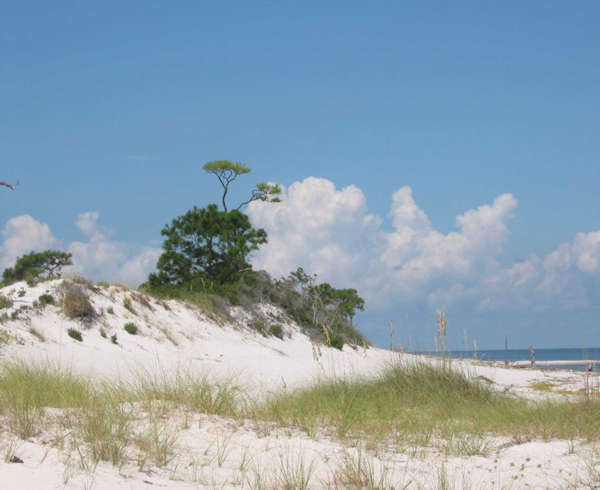 National Seashore, and as such, is administered by the National Park ServiceAfter the War of 1812, the
National Seashore, and as such, is administered by the National Park ServiceAfter the War of 1812, the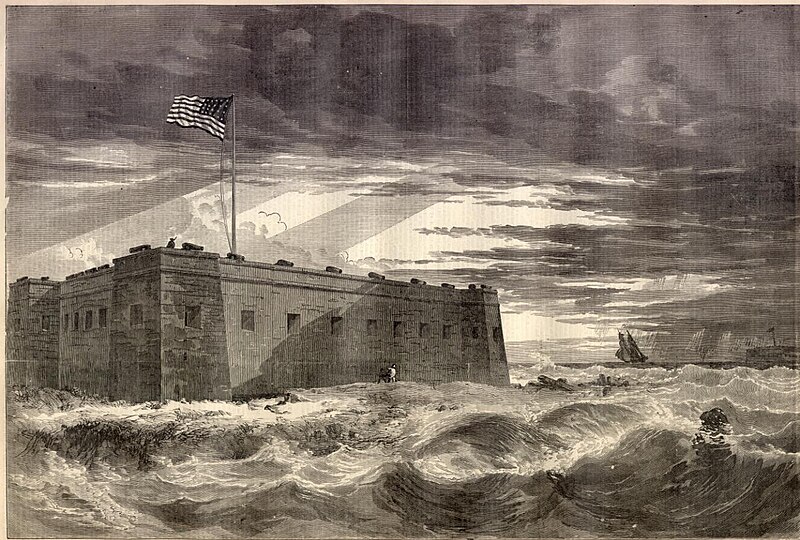 United States decided to fortify all of its major ports, and as a result,
United States decided to fortify all of its major ports, and as a result, French engineer Simon Bernard was appointed to design Fort Pickens. Construction on Fort Pickens lasted from 1829 to 1834, with 21.5 million bricks being used to build the fort. Much of the construction was done by slave labor.
French engineer Simon Bernard was appointed to design Fort Pickens. Construction on Fort Pickens lasted from 1829 to 1834, with 21.5 million bricks being used to build the fort. Much of the construction was done by slave labor.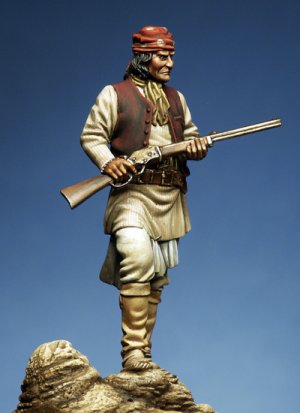

as regards the afro americans serving in florida a new dispute has broken out
A textbook distributed to Virginia fourth-graders says that thousands of African Americans fought for the South during the Civil War -- a claim rejected by most historians but often made by groups seeking to play down slavery's role as a cause of the conflict.
The passage appears in "Our Virginia: Past and Present," which was distributed in the state's public elementary schools for the first time last month. The author, Joy Masoff, who is not a trained historian but has written several books, said she found the information about black Confederate soldiers primarily through Internet research, which turned up work by members of the Sons of Confederate Veterans.
Scholars are nearly unanimous in calling these accounts of black Confederate soldiers a misrepresentation of history. Virginia education officials, after being told by The Washington Post of the issues related to the textbook, said that the vetting of the book was flawed and that they will contact school districts across the state to caution them against teaching the passage.
"Just because a book is approved doesn't mean the Department of Education endorses every sentence," said spokesman Charles Pyle. He also called the book's assertion about black Confederate soldiers "outside mainstream Civil War scholarship."
Masoff defended her work. "As controversial as it is, I stand by what I write," she said. "I am a fairly respected writer."
The issues first came to light after College of William & Mary historian Carol Sheriff opened her daughter's copy of "Our Virginia" and saw the reference to black Confederate soldiers.
"It's disconcerting that the next generation is being taught history based on an unfounded claim instead of accepted scholarship," Sheriff said. "It concerns me not just as a professional historian but as a parent."
Virginia, which is preparing to mark the 150th anniversary of the beginning of the Civil War, has long struggled to appropriately commemorate its Confederate past. The debate was reinvigorated this spring, when Gov. Robert F. McDonnell (R) introduced "Confederate History Month" in Virginia without mentioning slavery's role in the Civil War. He later apologized.
The Sons of Confederate Veterans, a group of male descendants of Confederate soldiers based in Columbia, Tenn., has long maintained that substantial numbers of black soldiers fought for the South The group's historian-in-chief, Charles Kelly Barrow, has written the book "Black Confederates."
The Sons of Confederate Veterans also disputes the widely accepted conclusion that the struggle over slavery was the main cause of the Civil War. Instead, the group says, the war was fought "to preserve their homes and livelihood," according to John Sawyer, chief of staff of the Sons of Confederate Veterans' Army of Northern Virginia. He said the group was pleased that a state textbook accepted some of its views.
The state's curriculum requires textbook publishers and educators to explore the role African Americans played in the Confederacy, including their work on plantations and on the sidelines of battle. Those standards have evolved in recent years to make lessons on the Civil War more inclusive in a state that is growing increasingly diverse.
When Masoff began work on the textbook, she said she consulted a variety of sources -- history books, experts and the Internet. But when it came to one of the Civil War's most controversial themes -- the role of African Americans in the Confederacy -- she relied primarily on an Internet search.
The book's publisher, Five Ponds Press, based in Weston, Conn., sent a Post reporter three of the links Masoff found on the Internet. Each referred to work by Sons of the Confederate Veterans or others who contend that the fight over slavery was not the main cause of the Civil War.
In its short lesson on the roles that whites, African Americans and Indians played in the Civil War, "Our Virginia" says, "Thousands of Southern blacks fought in the Confederate ranks, including two black battalions under the command of Stonewall Jackson."
Masoff said of the assertion: "It's just one sentence. I don't want to ruffle any feathers. If the historians had contacted me and asked me to take it out, I would have."
She added that the book was reviewed by a publisher's advisory council of educators and that none of the advisers objected to the textbook's assertion.
Historians from across the country, however, said the sentence about Confederate soldiers was wrong or, at the least, overdrawn. They expressed concerns not only over its accuracy but over the implications of publishing an assertion so closely linked to revisionist Confederate history.
"It's more than just an arcane, off-the-wall problem," said David Blight, a professor at Yale University. "This isn't just about the legitimacy of the Confederacy, it's about the legitimacy of the emancipation itself."
Pulitzer Prize-winning historian James McPherson of Princeton University said, "These Confederate heritage groups have been making this claim for years as a way of purging their cause of its association with slavery."A textbook distributed to Virginia fourth-graders says that thousands of African Americans fought for the South during the Civil War -- a claim rejected by most historians but often made by groups seeking to play down slavery's role as a cause of the conflict.
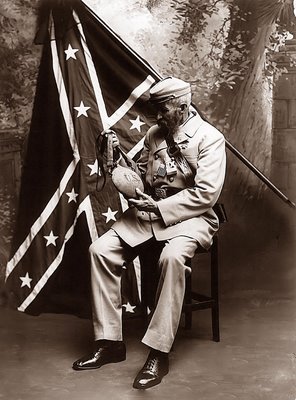
Masoff defended her work. "As controversial as it is, I stand by what I write," she said. "I am a fairly respected writer."
The issues first came to light after College of William & Mary historian Carol Sheriff opened her daughter's copy of "Our Virginia" and saw the reference to black Confederate soldiers.
"It's disconcerting that the next generation is being taught history based on an unfounded claim instead of accepted scholarship," Sheriff said. "It concerns me not just as a professional historian but as a parent."
Virginia, which is preparing to mark the 150th anniversary of the beginning of the Civil War, has long struggled to appropriately commemorate its Confederate past. The debate was reinvigorated this spring, when Gov. Robert F. McDonnell (R) introduced "Confederate History Month" in Virginia without mentioning slavery's role in the Civil War. He later apologized.
The Sons of Confederate Veterans, a group of male descendants of Confederate soldiers based in Columbia, Tenn., has long maintained that substantial numbers of black soldiers fought for the South The group's historian-in-chief, Charles Kelly Barrow, has written the book "Black Confederates."
The Sons of Confederate Veterans also disputes the widely accepted conclusion that the struggle over slavery was the main cause of the Civil War. Instead, the group says, the war was fought "to preserve their homes and livelihood," according to John Sawyer, chief of staff of the Sons of Confederate Veterans' Army of Northern Virginia. He said the group was pleased that a state textbook accepted some of its views.
The state's curriculum requires textbook publishers and educators to explore the role African Americans played in the Confederacy, including their work on plantations and on the sidelines of battle. Those standards have evolved in recent years to make lessons on the Civil War more inclusive in a state that is growing increasingly diverse.
When Masoff began work on the textbook, she said she consulted a variety of sources -- history books, experts and the Internet. But when it came to one of the Civil War's most controversial themes -- the role of African Americans in the Confederacy -- she relied primarily on an Internet search.
The book's publisher, Five Ponds Press, based in Weston, Conn., sent a Post reporter three of the links Masoff found on the Internet. Each referred to work by Sons of the Confederate Veterans or others who contend that the fight over slavery was not the main cause of the Civil War.
In its short lesson on the roles that whites, African Americans and Indians played in the Civil War, "Our Virginia" says, "Thousands of Southern blacks fought in the Confederate ranks, including two black battalions under the command of Stonewall Jackson."
Masoff said of the assertion: "It's just one sentence. I don't want to ruffle any feathers. If the historians had contacted me and asked me to take it out, I would have."
She added that the book was reviewed by a publisher's advisory council of educators and that none of the advisers objected to the textbook's assertion.
Historians from across the country, however, said the sentence about Confederate soldiers was wrong or, at the least, overdrawn. They expressed concerns not only over its accuracy but over the implications of publishing an assertion so closely linked to revisionist Confederate history.
"It's more than just an arcane, off-the-wall problem," said David Blight, a professor at Yale University. "This isn't just about the legitimacy of the Confederacy, it's about the legitimacy of the emancipation itself."
Pulitzer Prize-winning historian James McPherson of Princeton University said, "These Confederate heritage groups have been making this claim for years as a way of purging their cause of its association with slavery."
A textbook distributed to Virginia fourth-graders says that thousands of African Americans fought for the South during the Civil War -- a claim rejected by most historians but often made by groups seeking to play down slavery's role as a cause of the conflict.
The passage appears in "Our Virginia: Past and Present," which was distributed in the state's public elementary schools for the first time last month. The author, Joy Masoff, who is not a trained historian but has written several books, said she found the information about black Confederate soldiers primarily through Internet research, which turned up work by members of the Sons of Confederate Veterans.
Scholars are nearly unanimous in calling these accounts of black Confederate soldiers a misrepresentation of history. Virginia education officials, after being told by The Washington Post of the issues related to the textbook, said that the vetting of the book was flawed and that they will contact school districts across the state to caution them against teaching the passage.
"Just because a book is approved doesn't mean the Department of Education endorses every sentence," said spokesman Charles Pyle. He also called the book's assertion about black Confederate soldiers "outside mainstream Civil War scholarship."
Masoff defended her work. "As controversial as it is, I stand by what I write," she said. "I am a fairly respected writer."
The issues first came to light after College of William & Mary historian Carol Sheriff opened her daughter's copy of "Our Virginia" and saw the reference to black Confederate soldiers.
"It's disconcerting that the next generation is being taught history based on an unfounded claim instead of accepted scholarship," Sheriff said. "It concerns me not just as a professional historian but as a parent."
Virginia, which is preparing to mark the 150th anniversary of the beginning of the Civil War, has long struggled to appropriately commemorate its Confederate past. The debate was reinvigorated this spring, when Gov. Robert F. McDonnell (R) introduced "Confederate History Month" in Virginia without mentioning slavery's role in the Civil War. He later apologized.
The Sons of Confederate Veterans, a group of male descendants of Confederate soldiers based in Columbia, Tenn., has long maintained that substantial numbers of black soldiers fought for the South The group's historian-in-chief, Charles Kelly Barrow, has written the book "Black Confederates."
The Sons of Confederate Veterans also disputes the widely accepted conclusion that the struggle over slavery was the main cause of the Civil War. Instead, the group says, the war was fought "to preserve their homes and livelihood," according to John Sawyer, chief of staff of the Sons of Confederate Veterans' Army of Northern Virginia. He said the group was pleased that a state textbook accepted some of its views.
The state's curriculum requires textbook publishers and educators to explore the role African Americans played in the Confederacy, including their work on plantations and on the sidelines of battle. Those standards have evolved in recent years to make lessons on the Civil War more inclusive in a state that is growing increasingly diverse.
When Masoff began work on the textbook, she said she consulted a variety of sources -- history books, experts and the Internet. But when it came to one of the Civil War's most controversial themes -- the role of African Americans in the Confederacy -- she relied primarily on an Internet search.
The book's publisher, Five Ponds Press, based in Weston, Conn., sent a Post reporter three of the links Masoff found on the Internet. Each referred to work by Sons of the Confederate Veterans or others who contend that the fight over slavery was not the main cause of the Civil War.
In its short lesson on the roles that whites, African Americans and Indians played in the Civil War, "Our Virginia" says, "Thousands of Southern blacks fought in the Confederate ranks, including two black battalions under the command of Stonewall Jackson."
Masoff said of the assertion: "It's just one sentence. I don't want to ruffle any feathers. If the historians had contacted me and asked me to take it out, I would have."
She added that the book was reviewed by a publisher's advisory council of educators and that none of the advisers objected to the textbook's assertion.
Historians from across the country, however, said the sentence about Confederate soldiers was wrong or, at the least, overdrawn. They expressed concerns not only over its accuracy but over the implications of publishing an assertion so closely linked to revisionist Confederate history.
"It's more than just an arcane, off-the-wall problem," said David Blight, a professor at Yale University. "This isn't just about the legitimacy of the Confederacy, it's about the legitimacy of the emancipation itself."
Pulitzer Prize-winning historian James McPherson of Princeton University said, "These Confederate heritage groups have been making this claim for years as a way of purging their cause of its association with slavery."A textbook distributed to Virginia fourth-graders says that thousands of African Americans fought for the South during the Civil War -- a claim rejected by most historians but often made by groups seeking to play down slavery's role as a cause of the conflict.
The passage appears in "Our Virginia: Past and Present," which was distributed in the state's public elementary schools for the first time last month. The author, Joy Masoff, who is not a trained historian but has written several books, said she found the information about black Confederate soldiers primarily through Internet research, which turned up work by members of the Sons of Confederate Veterans.
Scholars are nearly unanimous in calling these accounts of black Confederate soldiers a misrepresentation of history. Virginia education officials, after being told by The Washington Post of the issues related to the textbook, said that the vetting of the book was flawed and that they will contact school districts across the state to caution them against teaching the passage.
"Just because a book is approved doesn't mean the Department of Education endorses every sentence," said spokesman Charles Pyle. He also called the book's assertion about black Confederate soldiers "outside mainstream Civil War scholarship."
Masoff defended her work. "As controversial as it is, I stand by what I write," she said. "I am a fairly respected writer."
The issues first came to light after College of William & Mary historian Carol Sheriff opened her daughter's copy of "Our Virginia" and saw the reference to black Confederate soldiers.
"It's disconcerting that the next generation is being taught history based on an unfounded claim instead of accepted scholarship," Sheriff said. "It concerns me not just as a professional historian but as a parent."
Virginia, which is preparing to mark the 150th anniversary of the beginning of the Civil War, has long struggled to appropriately commemorate its Confederate past. The debate was reinvigorated this spring, when Gov. Robert F. McDonnell (R) introduced "Confederate History Month" in Virginia without mentioning slavery's role in the Civil War. He later apologized.
The Sons of Confederate Veterans, a group of male descendants of Confederate soldiers based in Columbia, Tenn., has long maintained that substantial numbers of black soldiers fought for the South The group's historian-in-chief, Charles Kelly Barrow, has written the book "Black Confederates."
The Sons of Confederate Veterans also disputes the widely accepted conclusion that the struggle over slavery was the main cause of the Civil War. Instead, the group says, the war was fought "to preserve their homes and livelihood," according to John Sawyer, chief of staff of the Sons of Confederate Veterans' Army of Northern Virginia. He said the group was pleased that a state textbook accepted some of its views.
The state's curriculum requires textbook publishers and educators to explore the role African Americans played in the Confederacy, including their work on plantations and on the sidelines of battle. Those standards have evolved in recent years to make lessons on the Civil War more inclusive in a state that is growing increasingly diverse.
When Masoff began work on the textbook, she said she consulted a variety of sources -- history books, experts and the Internet. But when it came to one of the Civil War's most controversial themes -- the role of African Americans in the Confederacy -- she relied primarily on an Internet search.
The book's publisher, Five Ponds Press, based in Weston, Conn., sent a Post reporter three of the links Masoff found on the Internet. Each referred to work by Sons of the Confederate Veterans or others who contend that the fight over slavery was not the main cause of the Civil War.
In its short lesson on the roles that whites, African Americans and Indians played in the Civil War, "Our Virginia" says, "Thousands of Southern blacks fought in the Confederate ranks, including two black battalions under the command of Stonewall Jackson."
Masoff said of the assertion: "It's just one sentence. I don't want to ruffle any feathers. If the historians had contacted me and asked me to take it out, I would have."
She added that the book was reviewed by a publisher's advisory council of educators and that none of the advisers objected to the textbook's assertion.
Historians from across the country, however, said the sentence about Confederate soldiers was wrong or, at the least, overdrawn. They expressed concerns not only over its accuracy but over the implications of publishing an assertion so closely linked to revisionist Confederate history.
"It's more than just an arcane, off-the-wall problem," said David Blight, a professor at Yale University. "This isn't just about the legitimacy of the Confederacy, it's about the legitimacy of the emancipation itself."
Pulitzer Prize-winning historian James McPherson of Princeton University said, "These Confederate heritage groups have been making this claim for years as a way of purging their cause of its association with slavery."
Report of Dr. Lewis H. Steiner, M.D., Inspector of The Sanitary Commission, Containing a Diary Kept During the Rebel Occupation of Frederick, Md. An Account of the Operations Of The U. S. Sanitary Commission during the campaign in Maryland, September, 1862, Published by permission of The Sanitary Commission, New York, Anson D. F. Randolph, No. 683 Broadway, 1862, at pages 19-20:

Wednesday, September 10.— At four o clock this morning the rebel army began to move from our town, Jackson's force taking the advance. The movement continued until eight o'clock P. M., occupying sixteen hours. The most liberal calculations could not give them more than 60,000 men. Over 3,000 negroes must be included in this number. These were clad in all kinds of uniforms, not only in cast-off or captured United States uniforms, but in coats with Southern buttons, State buttons, etc. These were shabby, but not shabbier or seedier than those worn bv white men in the rebel ranks. Most of the negroes had arms, rifles, muskets, sabres, bowie-knives, dirks, etc.They were supplied, in many instances, with knapsacks, haversacks, canteens, etc., and were manifestly an integral portion of the Southern Confederacy Army. They were seen riding on horses and mules, driving wagons, riding on caissons, in ambulances, with the staff of Generals, and promiscuously mixed up with all the rebel horde. The fact was patent, and rather interesting when considered in connection with the horror rebels express at the suggestion of black soldiers being employed for the National defence.To Die in Chicago, Confederate Prisoners at Camp Douglas 1862-65, by George Levy, at page 179:
General Morgan had ignored orders from Richmond to report the presence of blacks in his army. As a result, many were captured on free soil in Confederate uniforms. The army held black prisoners at Camp Douglas despite President Lincoln's Emancipation Proclamation of January 1, 1863, which declared that slaves captured captured with Rebel forces would be "forever free." A War Department order on April 24, 1863, reinforced this command, declaring that slaves captured from belligerents were "entitled to the rights and privileges of free men." It seems that these men were not considered slaves.HISTORY CHANNEL DOCUMENTARY
"80 Acres of Hell" re Camp Douglas, Illinois
Recorded on 1/15/2006
Running Time: 2:00 hours
John Hunt Morgan's men raided Northern territory during July 1863. Those who were captured were transferred to Camp Douglas. The following extract describes their arrival. Quoted from the closed caption text.
Extract begins at 1:18.24 and ends 1:19.48
The new tone of Camp Douglas is set as soon as Morgan's men arrive. The guards had a special hatred for black rebels. There was a special animosity towards a black soldier caught in the Confederate uniform. And a black soldier caught on free soil was executed, and that happened at Camp Douglas when the prisoners from Morgan's raid came through the gates on August 18. [1863]Unfortunately, there was a young black slave who had been taken along on Morgan's raid. He had ridden every day they rode. He fought every day that they fought. And he looked like a Confederate soldier. He was wearing the cap. He had the Confederate uniform on.
When he came through the gates, the guard shot him to death. And the other prisoners couldn't understand. They said, "What did he do? Why did they kill this young black soldier." And they didn't know about the unspoken rule that any black Confederate caught on free soil was forfeit.
"The first prisoner they shot after we were put in was a Negro boy. I saw him the next day in the dead house, and the rats had eaten off his ears.Geronimo"was imprisoned in Fort Pickens, along with severaDURING OUR WAR OF 1861, ex-slave Frederick Douglass observed, "There are at the present moment, many colored men in the Confederate Army doing duty not only as cooks, servants and laborers, but as real soldiers, having muskets on their shoulders and bullets in their pockets, ready to shoot down ... and do all that soldiers may do to destroy the Federal government."
Dr. Lewis Steiner, a Union Sanitary Commission employee who lived through the Confederate occupation of Frederick, Maryland said, "Most of the Negroes ... were manifestly an integral portion of the Southern Confederacy Army." Erwin L. Jordan's book "Black Confederates and Afro-Yankees in Civil War Virginia" cites eyewitness accounts of the Antietam campaign of "armed blacks in rebel columns bearing rifles, sabers, and knives and carrying knapsacks and haversacks." After the Battle of Seven Pines in June 1862, Union soldiers said that "two black Confederate regiments not only fought but showed no mercy to the Yankee dead or wounded whom they mutilated, murdered and robbed."
In April 1861, a Petersburg, Virginia newspaper proposed "three cheers for the patriotic free Negroes of Lynchburg" after 70 blacks offered "to act in whatever capacity may be assigned to them" in defense of Virginia. Erwin L. Jordan cites one case where a captured group of white slave owners and blacks were offered freedom if they would take an oath of allegiance to the United States. One free black indignantly replied, "I can't take no such oaf as dat. I'm a secesh nigger." A slave in the group upon learning that his master refused to take the oath said, "I can't take no oath dat Massa won't take." A second slave said, "I ain't going out here on no dishonorable terms." One of the slave owners took the oath but his slave, who didn't take the oath, returning to Virginia under a flag of truce, expressed disgust at his master's disloyalty saying, "Massa had no principles."
Horace Greeley, in pointing out some differences between the two warring armies said, "For more than two years, Negroes have been extensively employed in belligerent operations by the Confederacy. They have been embodied and drilled as rebel soldiers and had paraded with white troops at a time when this would not have been tolerated in the armies of the Union." General Nathan Bedford Forrest had both slaves and freemen serving in units under his command. After the war, General Forrest said of the black men who served under him "(T)hese boys stayed with me ... and better Confederates did not live."
It was not just Southern generals who owned slaves but northern generals owned them as well. General Ulysses Grant's slaves had to await the Thirteenth Amendment for freedom. When asked why he didn't free his slaves earlier, General Grant said, "Good help is so hard to come by these days."
These are but a few examples of the important role that blacks served, both as slaves and freemen in the Confederacy during the War Between the States.
The flap over the Confederate flag is not quite as simple as the nation's race experts make it. They want us to believe the flag is a symbol of racism. Yes, racists have used the Confederate flag, but racists have also used the Bible and the U.S. flag. Should we get rid of the Bible and lower the U.S. flag? Black civil rights activists and their white liberal supporters who're attacking the Confederate flag have committed a deep, despicable dishonor to our patriotic black ancestors who marched, fought and died to protect their homeland from what they saw as Northern aggression.
They don't deserve the  dishonor.l of his warriors. Their families were held at Fort Mario
dishonor.l of his warriors. Their families were held at Fort Mario
 n
n
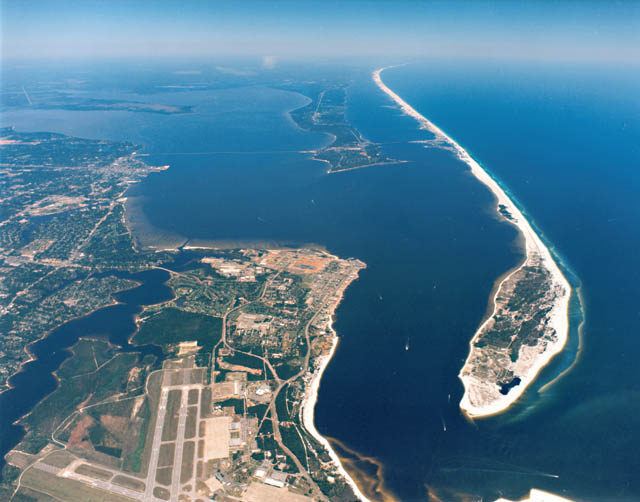 and Fort TaylorConstruction of the fort began in 1845 as part of a mid-19th century plan
and Fort TaylorConstruction of the fort began in 1845 as part of a mid-19th century plan to defend the southeast coast through a series of forts.
to defend the southeast coast through a series of forts. The fort was named for United States PresidentZachary Taylor in 1850, a few months after President Taylor's sudden death in office. Yellow fever epidemics and material shortages slowed construction of the fort, which continued throughout the 1850s. At the outset of the U.S. Civil War in 1861, Union Captain John Milton Brannan
The fort was named for United States PresidentZachary Taylor in 1850, a few months after President Taylor's sudden death in office. Yellow fever epidemics and material shortages slowed construction of the fort, which continued throughout the 1850s. At the outset of the U.S. Civil War in 1861, Union Captain John Milton Brannan seized control of the fort, preventing it from falling into Confederate hands and using it as an outpost to threaten blockade runners. Originally, the fort was surrounded by water on all sides, with a walkway linking it to the mainland. The fort was completed in 1866, although the upper level of one side was destroyed in 1889 to make way for more modern weapons, with the older cannons being buried within the new outer wall to save on materials. The fort was heavily used again during the 1898Spanish-American War. in Key
seized control of the fort, preventing it from falling into Confederate hands and using it as an outpost to threaten blockade runners. Originally, the fort was surrounded by water on all sides, with a walkway linking it to the mainland. The fort was completed in 1866, although the upper level of one side was destroyed in 1889 to make way for more modern weapons, with the older cannons being buried within the new outer wall to save on materials. The fort was heavily used again during the 1898Spanish-American War. in Key  West, along with Fort Jefferson Fort Jefferson is an unincorporated community and ghost town in
West, along with Fort Jefferson Fort Jefferson is an unincorporated community and ghost town in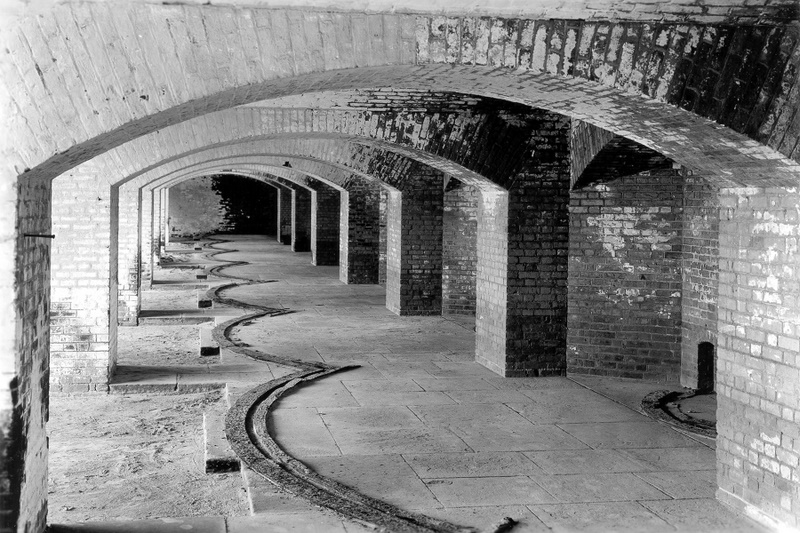 Monroe County, Florida, United States. It is located on Garden Key in the lower Florida Keys
Monroe County, Florida, United States. It is located on Garden Key in the lower Florida Keys 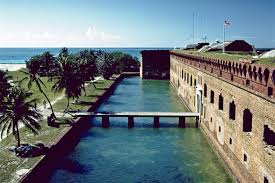 within the Dry Tortugas National park
within the Dry Tortugas National park about 70 miles (110 km) west of the island of Key West.
about 70 miles (110 km) west of the island of Key West. Fort Pickens was
Fort Pickens was the largest of a group of forts designed to fortify Pensacola Harbor. Constructed between 1829–1834, Pickens supplemented
the largest of a group of forts designed to fortify Pensacola Harbor. Constructed between 1829–1834, Pickens supplemented Fort Barranc
Fort Barranc
 dishonor.l of his warriors. Their families were held at Fort Mario
dishonor.l of his warriors. Their families were held at Fort Mario
 n
n
 and Fort TaylorConstruction of the fort began in 1845 as part of a mid-19th century plan
and Fort TaylorConstruction of the fort began in 1845 as part of a mid-19th century plan to defend the southeast coast through a series of forts.
to defend the southeast coast through a series of forts. The fort was named for United States PresidentZachary Taylor in 1850, a few months after President Taylor's sudden death in office. Yellow fever epidemics and material shortages slowed construction of the fort, which continued throughout the 1850s. At the outset of the U.S. Civil War in 1861, Union Captain John Milton Brannan
The fort was named for United States PresidentZachary Taylor in 1850, a few months after President Taylor's sudden death in office. Yellow fever epidemics and material shortages slowed construction of the fort, which continued throughout the 1850s. At the outset of the U.S. Civil War in 1861, Union Captain John Milton Brannan seized control of the fort, preventing it from falling into Confederate hands and using it as an outpost to threaten blockade runners. Originally, the fort was surrounded by water on all sides, with a walkway linking it to the mainland. The fort was completed in 1866, although the upper level of one side was destroyed in 1889 to make way for more modern weapons, with the older cannons being buried within the new outer wall to save on materials. The fort was heavily used again during the 1898Spanish-American War. in Key
seized control of the fort, preventing it from falling into Confederate hands and using it as an outpost to threaten blockade runners. Originally, the fort was surrounded by water on all sides, with a walkway linking it to the mainland. The fort was completed in 1866, although the upper level of one side was destroyed in 1889 to make way for more modern weapons, with the older cannons being buried within the new outer wall to save on materials. The fort was heavily used again during the 1898Spanish-American War. in Key  West, along with Fort Jefferson Fort Jefferson is an unincorporated community and ghost town in
West, along with Fort Jefferson Fort Jefferson is an unincorporated community and ghost town in Monroe County, Florida, United States. It is located on Garden Key in the lower Florida Keys
Monroe County, Florida, United States. It is located on Garden Key in the lower Florida Keys  about 70 miles (110 km) west of the island of Key West.
about 70 miles (110 km) west of the island of Key West. Fort Pickens was
Fort Pickens was the largest of a group of forts designed to fortify Pensacola Harbor. Constructed between 1829–1834, Pickens supplemented
the largest of a group of forts designed to fortify Pensacola Harbor. Constructed between 1829–1834, Pickens supplemented Fort Barranc
Fort Barranc and fort macree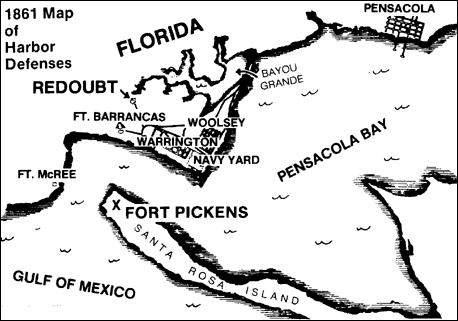 t
t  and the Navy Yard. Located at the western tip of Santa Rosa Island, just offshore from the mainland, Pickens guarded the island and the entrance to the harbor. Its construction was supervised by Colonel William H. Chase of the U.S. Army Corps of Engineers. Ironically, Chase was later appointed by the State of Florida to command its troops and seize for the South the very fort he had built. above fort macree today is hidden by trees
and the Navy Yard. Located at the western tip of Santa Rosa Island, just offshore from the mainland, Pickens guarded the island and the entrance to the harbor. Its construction was supervised by Colonel William H. Chase of the U.S. Army Corps of Engineers. Ironically, Chase was later appointed by the State of Florida to command its troops and seize for the South the very fort he had built. above fort macree today is hidden by trees
 and the Navy Yard. Located at the western tip of Santa Rosa Island, just offshore from the mainland, Pickens guarded the island and the entrance to the harbor. Its construction was supervised by Colonel William H. Chase of the U.S. Army Corps of Engineers. Ironically, Chase was later appointed by the State of Florida to command its troops and seize for the South the very fort he had built. above fort macree today is hidden by trees
and the Navy Yard. Located at the western tip of Santa Rosa Island, just offshore from the mainland, Pickens guarded the island and the entrance to the harbor. Its construction was supervised by Colonel William H. Chase of the U.S. Army Corps of Engineers. Ironically, Chase was later appointed by the State of Florida to command its troops and seize for the South the very fort he had built. above fort macree today is hidden by treesFort Jefferson is a massive but unfinished coastal fortress. It is the largest masonry structure in the Western Hemisphere,and is composed of over 16 million bricks.. in the Dry Tortugas, the Union had access to strategic outposts in the deep South.
in the Dry Tortugas, the Union had access to strategic outposts in the deep South.
 in the Dry Tortugas, the Union had access to strategic outposts in the deep South.
in the Dry Tortugas, the Union had access to strategic outposts in the deep South.
Over the course of the war, the Union army increased its occupation of most of Florida's coastal forts and towns. Unlike many other areas of the South, Florida saw minimal large-scale fighting.
Unlike many other areas of the South, Florida saw minimal large-scale fighting. With the exception of the Olustee campaign and several small expeditions into the interior, the Union army usually remained near its forts and occupied cities. Duty in some places, such as St. Augustine,
With the exception of the Olustee campaign and several small expeditions into the interior, the Union army usually remained near its forts and occupied cities. Duty in some places, such as St. Augustine, could be interesting for northern troops. However, many were stationed in remote locations and
could be interesting for northern troops. However, many were stationed in remote locations and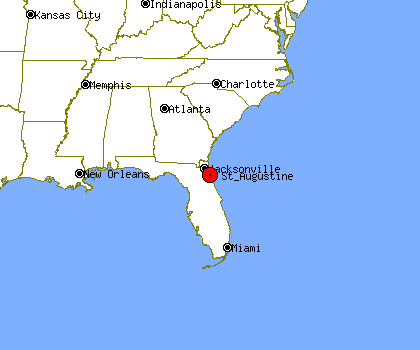 suffered from boredom, insects, and potentially deadly tropical diseases such as yellow fever.
suffered from boredom, insects, and potentially deadly tropical diseases such as yellow fever.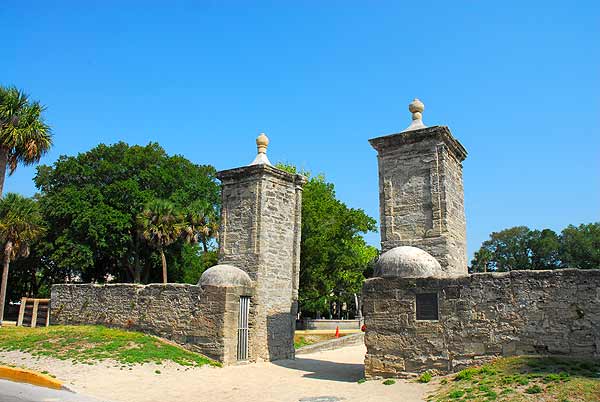
 Unlike many other areas of the South, Florida saw minimal large-scale fighting.
Unlike many other areas of the South, Florida saw minimal large-scale fighting. With the exception of the Olustee campaign and several small expeditions into the interior, the Union army usually remained near its forts and occupied cities. Duty in some places, such as St. Augustine,
With the exception of the Olustee campaign and several small expeditions into the interior, the Union army usually remained near its forts and occupied cities. Duty in some places, such as St. Augustine, could be interesting for northern troops. However, many were stationed in remote locations and
could be interesting for northern troops. However, many were stationed in remote locations and suffered from boredom, insects, and potentially deadly tropical diseases such as yellow fever.
suffered from boredom, insects, and potentially deadly tropical diseases such as yellow fever.
A variety of northern units served in Florida, from the New York Zouaves to the Union army's African American regiments. In the latter two years of the war, an increasing number of black units were involved in the Union operations in Florida. In addition to fighting at Olustee, both black and white Union army units stationed in different parts of the state fought small battles with southern forces at Gainesville, Marianna, Station Number 4 near Cedar Key, Fort Myers, and Natural Bridge. Smaller skirmishes also occurred in other parts of the state.By mid-1862 most of Florida's soldiers had been sent outside the state. In the Army of Northern Virginia, Florida units were organized into a Florida Brigade. Later, a second Florida Brigade was formed from units serving in the other major Confederate army, the Army of
In the latter two years of the war, an increasing number of black units were involved in the Union operations in Florida. In addition to fighting at Olustee, both black and white Union army units stationed in different parts of the state fought small battles with southern forces at Gainesville, Marianna, Station Number 4 near Cedar Key, Fort Myers, and Natural Bridge. Smaller skirmishes also occurred in other parts of the state.By mid-1862 most of Florida's soldiers had been sent outside the state. In the Army of Northern Virginia, Florida units were organized into a Florida Brigade. Later, a second Florida Brigade was formed from units serving in the other major Confederate army, the Army of  Tennessee. Floridians fought in most of the major battles of the war, including the epic Battle of Gettysburg, where they suffered heavy casualties.
Tennessee. Floridians fought in most of the major battles of the war, including the epic Battle of Gettysburg, where they suffered heavy casualties.
 In the latter two years of the war, an increasing number of black units were involved in the Union operations in Florida. In addition to fighting at Olustee, both black and white Union army units stationed in different parts of the state fought small battles with southern forces at Gainesville, Marianna, Station Number 4 near Cedar Key, Fort Myers, and Natural Bridge. Smaller skirmishes also occurred in other parts of the state.By mid-1862 most of Florida's soldiers had been sent outside the state. In the Army of Northern Virginia, Florida units were organized into a Florida Brigade. Later, a second Florida Brigade was formed from units serving in the other major Confederate army, the Army of
In the latter two years of the war, an increasing number of black units were involved in the Union operations in Florida. In addition to fighting at Olustee, both black and white Union army units stationed in different parts of the state fought small battles with southern forces at Gainesville, Marianna, Station Number 4 near Cedar Key, Fort Myers, and Natural Bridge. Smaller skirmishes also occurred in other parts of the state.By mid-1862 most of Florida's soldiers had been sent outside the state. In the Army of Northern Virginia, Florida units were organized into a Florida Brigade. Later, a second Florida Brigade was formed from units serving in the other major Confederate army, the Army of  Tennessee. Floridians fought in most of the major battles of the war, including the epic Battle of Gettysburg, where they suffered heavy casualties.
Tennessee. Floridians fought in most of the major battles of the war, including the epic Battle of Gettysburg, where they suffered heavy casualties. Patriotism for the southern cause, so common at the beginning of the war, was later tempered by exposure to an increasing amount of death and suffering. At first, the South relied on volunteers, but as early as April 1862 it was necessary to institute a draft in order to fill the ranks. Draftees and those disillusioned by years of war increasingly deserted the Confederate ranks in the latter part of the conflict. Bands of deserters in Florida operated against southern authority in parts of the state. 
Approximately 5,000 Floridians (about one out of every three soldiers) died or were killed in Confederate service. Many of those who survived were disabled or had their lives shortened due to health problems related to the hardships of military service.Florida in the American Civil War served the Confederate States of America from the beginning of the Civil War. Following Abraham Lincoln's election in 1860, the state of Florida joined other Southern states in declaring secession from the Union, the third of the original seven states to do so.

With a small population, Florida would contribute more goods to the Confederate cause than manpower. It produced large amounts of sustenance and its large coastline made it difficult for Union Navy efforts to curb  Cavalry guidon (flag) of the "St. Johns Rangers," Company B, 2nd Florida Cavalry (C.S.A)
Cavalry guidon (flag) of the "St. Johns Rangers," Company B, 2nd Florida Cavalry (C.S.A)
Made of silk, the forked-tail flag bears thirteen stars in a triangular pattern. The colorful banner was an example of a unique, finely made flag, probably presented to the unit by women related to soldiers in the unit. The guidon is associated with Captain Winston J. T. Stephens, who commanded the company.
blockade runners bringing in supplies and material from foreign markets.Secession was declared January 10, 1861, and, after less than a month, Florida became one of the founding members of the Confederacy. Although the vote to secede passed 62-7, there was a small pro-Union and anti-Confederate minority in the state, an element that grew as the war progressed.
 Cavalry guidon (flag) of the "St. Johns Rangers," Company B, 2nd Florida Cavalry (C.S.A)
Cavalry guidon (flag) of the "St. Johns Rangers," Company B, 2nd Florida Cavalry (C.S.A)Made of silk, the forked-tail flag bears thirteen stars in a triangular pattern. The colorful banner was an example of a unique, finely made flag, probably presented to the unit by women related to soldiers in the unit. The guidon is associated with Captain Winston J. T. Stephens, who commanded the company.
blockade runners bringing in supplies and material from foreign markets.Secession was declared January 10, 1861, and, after less than a month, Florida became one of the founding members of the Confederacy. Although the vote to secede passed 62-7, there was a small pro-Union and anti-Confederate minority in the state, an element that grew as the war progressed.

Florida sent a three-man delegation to the 1861-62 Provisional Confederate Congress, which first met inMontgomery, Alabama, and then in the new capital of Richmond, Virginia—Jackson Morton , James Byeram Owens, and James Patton Anderson, who resigned April 8, 1861, and was replaced by George Taliaferro Ward. Ward served from May 1861 until February 1862, when he resigned and was in turn replaced by John Pease Sanderson.Florida being an important supply route for the Confederate Army, Union forces operated a blockade around the entire state. Union troops occupied major ports such as Cedar Key
, James Byeram Owens, and James Patton Anderson, who resigned April 8, 1861, and was replaced by George Taliaferro Ward. Ward served from May 1861 until February 1862, when he resigned and was in turn replaced by John Pease Sanderson.Florida being an important supply route for the Confederate Army, Union forces operated a blockade around the entire state. Union troops occupied major ports such as Cedar Key , Jacksonville, Key West
, Jacksonville, Key West , and Pensacola. Confederate forces moved quickly to seize control of many of Florida's U.S. Army forts, succeeding in most cases with the significant exceptions of Fort Zachary Taylor and Fort Pickens, which stayed firmly in Federal control throughout the war.
, and Pensacola. Confederate forces moved quickly to seize control of many of Florida's U.S. Army forts, succeeding in most cases with the significant exceptions of Fort Zachary Taylor and Fort Pickens, which stayed firmly in Federal control throughout the war.
 , James Byeram Owens, and James Patton Anderson, who resigned April 8, 1861, and was replaced by George Taliaferro Ward. Ward served from May 1861 until February 1862, when he resigned and was in turn replaced by John Pease Sanderson.Florida being an important supply route for the Confederate Army, Union forces operated a blockade around the entire state. Union troops occupied major ports such as Cedar Key
, James Byeram Owens, and James Patton Anderson, who resigned April 8, 1861, and was replaced by George Taliaferro Ward. Ward served from May 1861 until February 1862, when he resigned and was in turn replaced by John Pease Sanderson.Florida being an important supply route for the Confederate Army, Union forces operated a blockade around the entire state. Union troops occupied major ports such as Cedar Key , Jacksonville, Key West
, Jacksonville, Key West , and Pensacola. Confederate forces moved quickly to seize control of many of Florida's U.S. Army forts, succeeding in most cases with the significant exceptions of Fort Zachary Taylor and Fort Pickens, which stayed firmly in Federal control throughout the war.
, and Pensacola. Confederate forces moved quickly to seize control of many of Florida's U.S. Army forts, succeeding in most cases with the significant exceptions of Fort Zachary Taylor and Fort Pickens, which stayed firmly in Federal control throughout the war.Governor John Milton , an ardent secessionist, throughout the war stressed the importance of Florida as a supplier of goods, rather than personnel, with Florida being a large provider of food (particularly beef cattle) and salt for the Confederate Army. The 13,000-mile coastline proved a haven for blockade runners and a daunting task for patrolling Federal warships. However, the state's small population (140,000 residents making it last in size in the Confederacy), relatively remote location, and meager industry limited its overall strategic importance. Nevertheless, Milton worked feverishly to strengthen the state militia and to improve fortifications and key defensive positions.
, an ardent secessionist, throughout the war stressed the importance of Florida as a supplier of goods, rather than personnel, with Florida being a large provider of food (particularly beef cattle) and salt for the Confederate Army. The 13,000-mile coastline proved a haven for blockade runners and a daunting task for patrolling Federal warships. However, the state's small population (140,000 residents making it last in size in the Confederacy), relatively remote location, and meager industry limited its overall strategic importance. Nevertheless, Milton worked feverishly to strengthen the state militia and to improve fortifications and key defensive positions.
 , an ardent secessionist, throughout the war stressed the importance of Florida as a supplier of goods, rather than personnel, with Florida being a large provider of food (particularly beef cattle) and salt for the Confederate Army. The 13,000-mile coastline proved a haven for blockade runners and a daunting task for patrolling Federal warships. However, the state's small population (140,000 residents making it last in size in the Confederacy), relatively remote location, and meager industry limited its overall strategic importance. Nevertheless, Milton worked feverishly to strengthen the state militia and to improve fortifications and key defensive positions.
, an ardent secessionist, throughout the war stressed the importance of Florida as a supplier of goods, rather than personnel, with Florida being a large provider of food (particularly beef cattle) and salt for the Confederate Army. The 13,000-mile coastline proved a haven for blockade runners and a daunting task for patrolling Federal warships. However, the state's small population (140,000 residents making it last in size in the Confederacy), relatively remote location, and meager industry limited its overall strategic importance. Nevertheless, Milton worked feverishly to strengthen the state militia and to improve fortifications and key defensive positions.Overall, the state raised some 15,000 troops for the Confederacy, which were organized into twelve regiments of infantry and two of cavalry, as well as several artillery batteries and supporting units. Since neither army aggressively sought control of Florida, many of Florida's best home-raised troops instead served in Virginia in the Army of Northern Virginiaunder Brig. Gen. Edward A. Perry and Col. David Lang
and Col. David Lang . The "Florida Brigade" fought with distinction in many of Robert E. Lee's campaigns, and twice charged Cemetery Ridgeduring the Battle of Gettysburg, including supporting Pickett's Charge.
. The "Florida Brigade" fought with distinction in many of Robert E. Lee's campaigns, and twice charged Cemetery Ridgeduring the Battle of Gettysburg, including supporting Pickett's Charge.
 and Col. David Lang
and Col. David Lang . The "Florida Brigade" fought with distinction in many of Robert E. Lee's campaigns, and twice charged Cemetery Ridgeduring the Battle of Gettysburg, including supporting Pickett's Charge.
. The "Florida Brigade" fought with distinction in many of Robert E. Lee's campaigns, and twice charged Cemetery Ridgeduring the Battle of Gettysburg, including supporting Pickett's Charge.
In early 1862, the Confederate government pulled General Braxton Bragg's
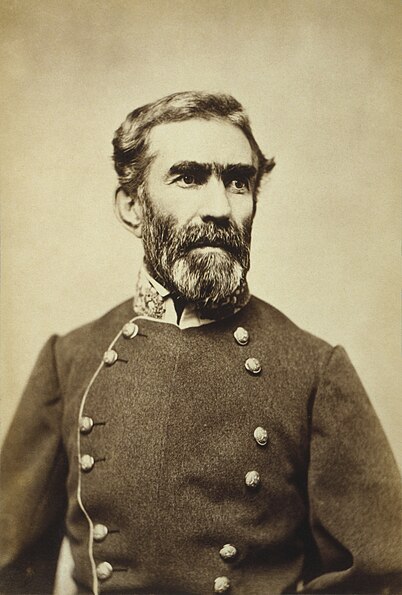 small army from Pensacola following successive Confederate defeats in Tennessee at Fort Donelson
small army from Pensacola following successive Confederate defeats in Tennessee at Fort Donelson  and Fort Henry
and Fort Henry and sent them to the Western Theater for the remainder of the war. The only Confederate forces remaining in Florida at that time were a variety of independent companies, several
and sent them to the Western Theater for the remainder of the war. The only Confederate forces remaining in Florida at that time were a variety of independent companies, several  infantry battalions, and the 2nd Florida Cavalry. They were reinforced in 1864 by troops
infantry battalions, and the 2nd Florida Cavalry. They were reinforced in 1864 by troops  from neighboring Georgia.By 1840 white Floridians were concentrating on developing the territory and gaining statehood. The population had reached 54,477 people, with African American slaves making up almost one-half of the population. Steamboat navigation was well established on the Apalachicola and St. Johns Rivers, and railroads were planned.
from neighboring Georgia.By 1840 white Floridians were concentrating on developing the territory and gaining statehood. The population had reached 54,477 people, with African American slaves making up almost one-half of the population. Steamboat navigation was well established on the Apalachicola and St. Johns Rivers, and railroads were planned.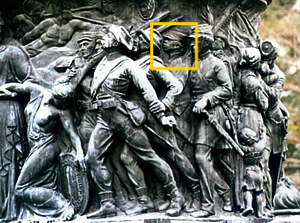
There were over 61,000 slaves in Florida in 1861. Their labor accounted for 85 percent of the state’s cotton production. Confederate authorities used slaves as teamsters to transport supplies and as laborers in salt works and fisheries. Many Florida slaves working in these coastal industries escaped to the relative safety of Union controlled enclaves.  Beginning in 1862, Union military activity in East and West Florida encouraged slaves in plantation areas to flee their owners in search of freedom. Some worked on Union ships and more than a thousand enlisted as soldiers and sailors in the U.S. military.
Beginning in 1862, Union military activity in East and West Florida encouraged slaves in plantation areas to flee their owners in search of freedom. Some worked on Union ships and more than a thousand enlisted as soldiers and sailors in the U.S. military.
 Beginning in 1862, Union military activity in East and West Florida encouraged slaves in plantation areas to flee their owners in search of freedom. Some worked on Union ships and more than a thousand enlisted as soldiers and sailors in the U.S. military.
Beginning in 1862, Union military activity in East and West Florida encouraged slaves in plantation areas to flee their owners in search of freedom. Some worked on Union ships and more than a thousand enlisted as soldiers and sailors in the U.S. military.Escaped and freed slaves provided Union commanders with valuable intelligence about Confederate troop movements and passed on news of Union advances to the men and women who remained enslaved in Confederate controlled Florida. Planter fears of slave uprisings increased as the war went on.
Dr. Leonard Haynes, an African-American professor at Southern University, stated, "When you eliminate the black Confederate soldier, you've eliminated the a part of the history of the South."
Dr. Leonard Haynes, an African-American professor at Southern University, stated, "When you eliminate the black Confederate soldier, you've eliminated the a part of the history of the South."
Though numerous small skirmishes occurred in Florida, including the Battle of Natural 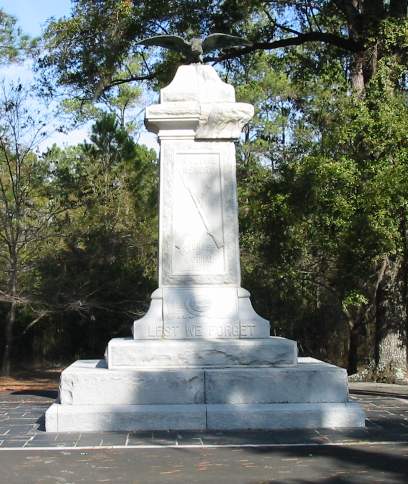 Bridge
Bridge The Battle of Natural Bridge was a battle during the American Civil War, fought in what is now Woodville, Florida,
The Battle of Natural Bridge was a battle during the American Civil War, fought in what is now Woodville, Florida, nearTallahassee
nearTallahassee , on March 6, 1865. A small band of Confederate troops and volunteers, mostly composed of teenagers from the nearby Florida Military and Collegiate Institute that would later become Florida State University, and the elderly, protected by breastworks, prevented Union forces (consisting of African-American soldiers of the United States Colored Troops)
, on March 6, 1865. A small band of Confederate troops and volunteers, mostly composed of teenagers from the nearby Florida Military and Collegiate Institute that would later become Florida State University, and the elderly, protected by breastworks, prevented Union forces (consisting of African-American soldiers of the United States Colored Troops)  from crossing the Natural Bridge on the St. Marks River
from crossing the Natural Bridge on the St. Marks River . This action prevented the Union from capturing the Florida capital and made Tallahassee the only Confederate capital east of the Mississippi River not to be captured by Union forces during the war., the Battle of Gainesville
. This action prevented the Union from capturing the Florida capital and made Tallahassee the only Confederate capital east of the Mississippi River not to be captured by Union forces during the war., the Battle of Gainesville The Battle of Gainesville (not to be confused with the First Skirmish of Gainesville of February 15, 1864) was
The Battle of Gainesville (not to be confused with the First Skirmish of Gainesville of February 15, 1864) was fought on August 17, 1864, when a Confederate force defeated Union detachments on a raid from the Union
fought on August 17, 1864, when a Confederate force defeated Union detachments on a raid from the Union garrison in the Jacksonville, Florida, area. However, the other and first Battle of Gainesville was fought on 14
garrison in the Jacksonville, Florida, area. However, the other and first Battle of Gainesville was fought on 14  Captain J.J. Dickison, CSA
Captain J.J. Dickison, CSA
The "Swamp Fox" of FloridaFebruary 1864, when a small unit associated with the February 1864 Florida Expedition, defeated a Confederate cavalry unit., and the Battle of Fort BrookeThe Battle of Fort Brooke was a minor engagement fought October 16–18, 1863, near Tampa, Florida, during theAmerican Civil War.
The Battle of Fort Brooke was a minor engagement fought October 16–18, 1863, near Tampa, Florida, during theAmerican Civil War.
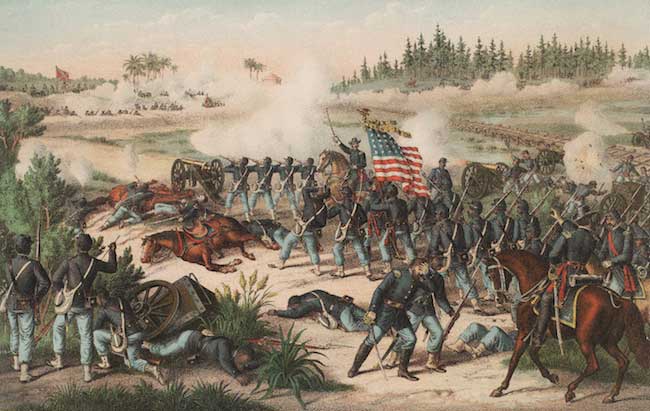 . Union forces under General Truman Seymour
. Union forces under General Truman Seymour were repulsed by Florida and Georgia troops and retreated to their fortifications around Jacksonville.
were repulsed by Florida and Georgia troops and retreated to their fortifications around Jacksonville. Seymour's relatively high losses caused Northernlawmakers and citizens to openly question the necessity of any further Union involvement in militarily insignificant Florida, and many of the Federal troops were withdrawn and sent elsewhere. Throughout the balance of 1864 and into the following spring, the 2nd Florida Cavalry repeatedly thwarted Federal raiding parties into the Confederate-held northern and central portions of the state.Growing public dissatisfaction with Confederate conscription and impressment policies
Seymour's relatively high losses caused Northernlawmakers and citizens to openly question the necessity of any further Union involvement in militarily insignificant Florida, and many of the Federal troops were withdrawn and sent elsewhere. Throughout the balance of 1864 and into the following spring, the 2nd Florida Cavalry repeatedly thwarted Federal raiding parties into the Confederate-held northern and central portions of the state.Growing public dissatisfaction with Confederate conscription and impressment policies  encouraged desertion by Confederate soldiers. Several Florida counties became havens for Florida deserters as well as deserters from other Confederate states. Deserter bands attacked Confederate patrols, launched raids on plantations, confiscated slaves, stole cattle, and provided intelligence to Union army units and naval blockaders. Although most deserters formed their own raiding bands or simply tried to remain free from Confederate authorities, other deserters and Unionist Floridians joined regular Federal units for military service in Florida.
encouraged desertion by Confederate soldiers. Several Florida counties became havens for Florida deserters as well as deserters from other Confederate states. Deserter bands attacked Confederate patrols, launched raids on plantations, confiscated slaves, stole cattle, and provided intelligence to Union army units and naval blockaders. Although most deserters formed their own raiding bands or simply tried to remain free from Confederate authorities, other deserters and Unionist Floridians joined regular Federal units for military service in Florida.
 Bridge
Bridge The Battle of Natural Bridge was a battle during the American Civil War, fought in what is now Woodville, Florida,
The Battle of Natural Bridge was a battle during the American Civil War, fought in what is now Woodville, Florida, nearTallahassee
nearTallahassee , on March 6, 1865. A small band of Confederate troops and volunteers, mostly composed of teenagers from the nearby Florida Military and Collegiate Institute that would later become Florida State University, and the elderly, protected by breastworks, prevented Union forces (consisting of African-American soldiers of the United States Colored Troops)
, on March 6, 1865. A small band of Confederate troops and volunteers, mostly composed of teenagers from the nearby Florida Military and Collegiate Institute that would later become Florida State University, and the elderly, protected by breastworks, prevented Union forces (consisting of African-American soldiers of the United States Colored Troops)  from crossing the Natural Bridge on the St. Marks River
from crossing the Natural Bridge on the St. Marks River . This action prevented the Union from capturing the Florida capital and made Tallahassee the only Confederate capital east of the Mississippi River not to be captured by Union forces during the war., the Battle of Gainesville
. This action prevented the Union from capturing the Florida capital and made Tallahassee the only Confederate capital east of the Mississippi River not to be captured by Union forces during the war., the Battle of Gainesville The Battle of Gainesville (not to be confused with the First Skirmish of Gainesville of February 15, 1864) was
The Battle of Gainesville (not to be confused with the First Skirmish of Gainesville of February 15, 1864) was fought on August 17, 1864, when a Confederate force defeated Union detachments on a raid from the Union
fought on August 17, 1864, when a Confederate force defeated Union detachments on a raid from the Union garrison in the Jacksonville, Florida, area. However, the other and first Battle of Gainesville was fought on 14
garrison in the Jacksonville, Florida, area. However, the other and first Battle of Gainesville was fought on 14  Captain J.J. Dickison, CSA
Captain J.J. Dickison, CSAThe "Swamp Fox" of FloridaFebruary 1864, when a small unit associated with the February 1864 Florida Expedition, defeated a Confederate cavalry unit., and the Battle of Fort BrookeThe Battle of Fort Brooke was a minor engagement fought October 16–18, 1863, near Tampa, Florida, during theAmerican Civil War.
Two Union Navy ships, USS Tahoma and USS Adela, bombarded Fort Brooke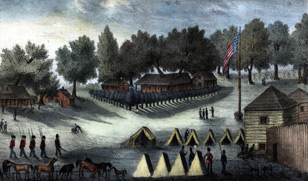 on October 16, 1863, as a diversion, while a landing party under Acting Master T.R. Harris disembarked at Ballast Point
on October 16, 1863, as a diversion, while a landing party under Acting Master T.R. Harris disembarked at Ballast Point and marched 14 miles to the Hillsborough Riverto capture several enemy steamers.
and marched 14 miles to the Hillsborough Riverto capture several enemy steamers.
 on October 16, 1863, as a diversion, while a landing party under Acting Master T.R. Harris disembarked at Ballast Point
on October 16, 1863, as a diversion, while a landing party under Acting Master T.R. Harris disembarked at Ballast Point and marched 14 miles to the Hillsborough Riverto capture several enemy steamers.
and marched 14 miles to the Hillsborough Riverto capture several enemy steamers.Harris and his men surprised and burned the blockade runner Scottish Chief and the sloop Kate Dale a few miles up the river near the site of today's Lowry Park Zoo. The Confederate defenders destroyed the steamer A.B. Noyes to preclude her capture.
On its way back to the ship, Harris's force was surprised by a detachment of the garrison, the 2nd Florida Infantry Battalion, causing casualties in a brief but sharp exchange before the Union troops returned to sea.The Battle of Fort Brooke was a minor engagement fought October 16–18, 1863, near Tampa, Florida, during theAmerican Civil War.
Two Union Navy ships, USS Tahoma and USS Adela, bombarded Fort Brooke on October 16, 1863, as a diversion, while a landing party under Acting Master T.R. Harris disembarked at Ballast Point and marched 14 miles to the Hillsborough Riverto
at Ballast Point and marched 14 miles to the Hillsborough Riverto capture several enemy steamers.
capture several enemy steamers.
 at Ballast Point and marched 14 miles to the Hillsborough Riverto
at Ballast Point and marched 14 miles to the Hillsborough Riverto capture several enemy steamers.
capture several enemy steamers.Harris and his men surprised and burned the blockade runner Scottish Chief and the sloop Kate Dale a few miles up the river near the site of today's Lowry Park Zoo. The Confederate defenders destroyed the steamer A.B. Noyes to preclude her capture.
The Confederate defenders destroyed the steamer A.B. Noyes to preclude her capture.
On its way back to the ship, Harris's force was surprised by a detachment of the garrison, the 2nd Florida Infantry Battalion, causing casualties in a brief but sharp exchange before the Union troops returned to sea., the only major battle was the Battle of Olustee near Lake City The Confederate defenders destroyed the steamer A.B. Noyes to preclude her capture.
The Confederate defenders destroyed the steamer A.B. Noyes to preclude her capture. . Union forces under General Truman Seymour
. Union forces under General Truman Seymour were repulsed by Florida and Georgia troops and retreated to their fortifications around Jacksonville.
were repulsed by Florida and Georgia troops and retreated to their fortifications around Jacksonville. Seymour's relatively high losses caused Northernlawmakers and citizens to openly question the necessity of any further Union involvement in militarily insignificant Florida, and many of the Federal troops were withdrawn and sent elsewhere. Throughout the balance of 1864 and into the following spring, the 2nd Florida Cavalry repeatedly thwarted Federal raiding parties into the Confederate-held northern and central portions of the state.Growing public dissatisfaction with Confederate conscription and impressment policies
Seymour's relatively high losses caused Northernlawmakers and citizens to openly question the necessity of any further Union involvement in militarily insignificant Florida, and many of the Federal troops were withdrawn and sent elsewhere. Throughout the balance of 1864 and into the following spring, the 2nd Florida Cavalry repeatedly thwarted Federal raiding parties into the Confederate-held northern and central portions of the state.Growing public dissatisfaction with Confederate conscription and impressment policies  encouraged desertion by Confederate soldiers. Several Florida counties became havens for Florida deserters as well as deserters from other Confederate states. Deserter bands attacked Confederate patrols, launched raids on plantations, confiscated slaves, stole cattle, and provided intelligence to Union army units and naval blockaders. Although most deserters formed their own raiding bands or simply tried to remain free from Confederate authorities, other deserters and Unionist Floridians joined regular Federal units for military service in Florida.
encouraged desertion by Confederate soldiers. Several Florida counties became havens for Florida deserters as well as deserters from other Confederate states. Deserter bands attacked Confederate patrols, launched raids on plantations, confiscated slaves, stole cattle, and provided intelligence to Union army units and naval blockaders. Although most deserters formed their own raiding bands or simply tried to remain free from Confederate authorities, other deserters and Unionist Floridians joined regular Federal units for military service in Florida.In January 1865, Union General William T. Sherman issued a set of special orders that set aside a portion of Florida as a designated home for runaway and freed former slaves that had accompanied his command during its March to the Sea. These controversial orders were not enforced in Florida, and were later revoked by President Andrew Johnson.

In early May 1865, Edward M. McCook's Union division was assigned to re-establish Federal control and authority in Florida, whose Governor Milton had shot himself in the head rather than submit to Union occupation.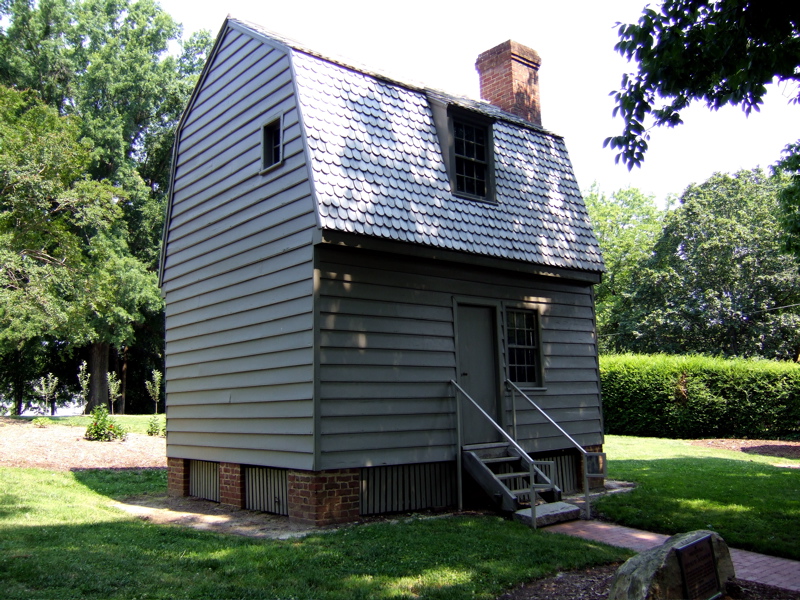 above johnsons home in childhood
above johnsons home in childhood
 above johnsons home in childhood
above johnsons home in childhoodOn May 13, Col. George Washington Scott surrendered the last active Confederate troops in the state to McCook. On May 20, General McCook read Lincoln’s Emancipation Proclamation during a ceremony in Tallahassee, officially ending slavery in Florida. That same day, his jubilant troopers raised the U.S. flag over the state capitol building. Tallahassee was the next to last Confederate state capital to fall to the Union army. Austin, Texas fell the next month
surrendered the last active Confederate troops in the state to McCook. On May 20, General McCook read Lincoln’s Emancipation Proclamation during a ceremony in Tallahassee, officially ending slavery in Florida. That same day, his jubilant troopers raised the U.S. flag over the state capitol building. Tallahassee was the next to last Confederate state capital to fall to the Union army. Austin, Texas fell the next month
Conditions for African Americans in Florida varied considerably during the war. The 1860 census recorded nearly 63,000 blacks in the state. Of this figure, almost 62,000 were listed as slaves, while less than 1,000 were free blacks. Because of the restrictive laws of the time, even those few who were "free" had only very limited freedom.

Conditions for African Americans in Florida varied considerably during the war. The 1860 census recorded nearly 63,000 blacks in the state. Of this figure, almost 62,000 were listed as slaves, while less than 1,000 were free blacks. Because of the restrictive laws of the time, even those few who were "free" had only very limited freedom.
The conditions of slavery in Florida often differed by region. In the cotton belt plantations of central north Florida, many enslaved blacks worked under a "gang system" in which large groups of agricultural workers labored from sunup to sundown. In east and west Florida, a "task system" was more common, which provided workers with a daily task quota and could allow some personal time after the tasks were completed. However, in some plantations both systems were used.
As enslaved residents in the Confederate states, most African Americans had little choice but to support the Confederate war effort. Some went to war as servants to white southern officers and some certainly fought as rebel soldiers according to douglas . Others toiled in hard labor when the Confederate military impressed enslaved blacks for labor projects, such as building fortifications and transportation systems.
Although many enslaved blacks remained on plantations during the war, many others who had an opportunity fled to Union-held areas, such as Jacksonville and Fernandina in  northwest Florida, where they lived as refugees. More than a thousand African American men from Florida joined the Union army, filling out the ranks of black regiments.Late in the war, in March 1865, a combined Union army and naval force assembled in the northern Gulf of Mexico off St. Mark's. Almost 1,000 Union troops, including several hundred Florida soldiers in the
northwest Florida, where they lived as refugees. More than a thousand African American men from Florida joined the Union army, filling out the ranks of black regiments.Late in the war, in March 1865, a combined Union army and naval force assembled in the northern Gulf of Mexico off St. Mark's. Almost 1,000 Union troops, including several hundred Florida soldiers in the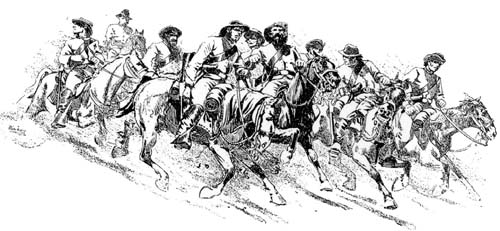 2nd Florida Union Cavalry, landed near the St. Mark's lighthouse
2nd Florida Union Cavalry, landed near the St. Mark's lighthouse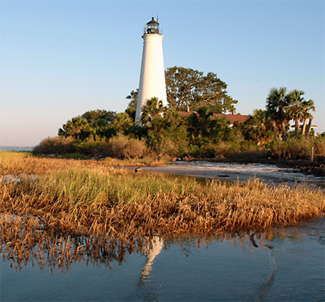 and prepared to move inland. The initial targets of the expedition appear to have been the town and fort of St. Mark's.
and prepared to move inland. The initial targets of the expedition appear to have been the town and fort of St. Mark's.  However, with a large Union force moving inland, the Confederates thought that there was a clear danger to the capital city, Tallahassee.
However, with a large Union force moving inland, the Confederates thought that there was a clear danger to the capital city, Tallahassee.
 northwest Florida, where they lived as refugees. More than a thousand African American men from Florida joined the Union army, filling out the ranks of black regiments.Late in the war, in March 1865, a combined Union army and naval force assembled in the northern Gulf of Mexico off St. Mark's. Almost 1,000 Union troops, including several hundred Florida soldiers in the
northwest Florida, where they lived as refugees. More than a thousand African American men from Florida joined the Union army, filling out the ranks of black regiments.Late in the war, in March 1865, a combined Union army and naval force assembled in the northern Gulf of Mexico off St. Mark's. Almost 1,000 Union troops, including several hundred Florida soldiers in the 2nd Florida Union Cavalry, landed near the St. Mark's lighthouse
2nd Florida Union Cavalry, landed near the St. Mark's lighthouse and prepared to move inland. The initial targets of the expedition appear to have been the town and fort of St. Mark's.
and prepared to move inland. The initial targets of the expedition appear to have been the town and fort of St. Mark's.  However, with a large Union force moving inland, the Confederates thought that there was a clear danger to the capital city, Tallahassee.
However, with a large Union force moving inland, the Confederates thought that there was a clear danger to the capital city, Tallahassee.
Following a skirmish at Newport bridge on the St. Mark's River , the Union commander, Brigadier General John Newton, decided to conduct a night march north to Natural Bridge in hopes of crossing the river unopposed. Observant Confederate scouts reported the move, and the southern field commander, Brigadier General William Miller, redirected his forces in the area to meet the threat. The southern troops consisted of both Florida cavalry and artillery soldiers, supplemented with young and old militia members, and a small group of young cadets from the Florida Military Institute in Tallahassee.
, the Union commander, Brigadier General John Newton, decided to conduct a night march north to Natural Bridge in hopes of crossing the river unopposed. Observant Confederate scouts reported the move, and the southern field commander, Brigadier General William Miller, redirected his forces in the area to meet the threat. The southern troops consisted of both Florida cavalry and artillery soldiers, supplemented with young and old militia members, and a small group of young cadets from the Florida Military Institute in Tallahassee.
 , the Union commander, Brigadier General John Newton, decided to conduct a night march north to Natural Bridge in hopes of crossing the river unopposed. Observant Confederate scouts reported the move, and the southern field commander, Brigadier General William Miller, redirected his forces in the area to meet the threat. The southern troops consisted of both Florida cavalry and artillery soldiers, supplemented with young and old militia members, and a small group of young cadets from the Florida Military Institute in Tallahassee.
, the Union commander, Brigadier General John Newton, decided to conduct a night march north to Natural Bridge in hopes of crossing the river unopposed. Observant Confederate scouts reported the move, and the southern field commander, Brigadier General William Miller, redirected his forces in the area to meet the threat. The southern troops consisted of both Florida cavalry and artillery soldiers, supplemented with young and old militia members, and a small group of young cadets from the Florida Military Institute in Tallahassee.
At dawn on March 6, 1865, the sound of gunfire could be heard at the Natural Bridge crossing. The first attempt by the Union troops to cross quickly was checked by southern fire. Both sides reinforced their positions during the morning, and the northern troops searched for another way across the river. Unable to find another crossing point, the federal commander chose to force a passage at Natural Bridge. Near midday the Union troops of the 2nd and 99th U.S. Colored Infantry regiments attacked. For several hours the woods and swamps echoed with the sounds of battle.
The Confederates had the advantages of a solid defensive position, more cannons, and, by the end of the battle, more troops. After finally realizing that they could not successfully force their way across Natural Bridge, the Union troops broke off the engagement and retreated to the safety of the coast. The battle resulted in 148 casualties for the northern side and 26 casualties for the southern side. The Confederate victory ensured that Tallahassee would remain in southern hands for the remainder of the war--the only southern capital east of the Mississippi River with that distinction.
No comments:
Post a Comment